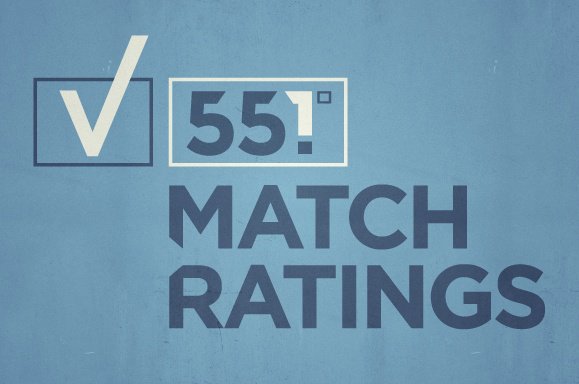FiftyFive.One gathers and keeps track of community match ratings for all competitive Loons matches, and uses post-match polls to collect those ratings. Staff and readers alike will be able to assign match ratings to Loons players via a post that will appear on our site following each Loons match, and remain open for roughly 48 hours. Feel free to contribute your ratings immediately following the match if you are watching at home, or do so the next day if you are out at the National Sports Center.
Some of you may already be familiar with the match ratings system commonly used by newspapers and video games like Football Manager. This may serve as an introduction for others. In any case, providing a bit of detail for the scale FiftyFive.One will be using will help make sure we are all speaking the same language. If you do intend to contribute, please take a moment to read what follows.
Match Ratings Primer
Assigning a numerical value to encompass the entirety of a player’s contribution in a match is inherently subjective and a gross simplification that stretches across the different roles and responsibilities with which players are tasked. However, that does not mean match ratings lack value.
To increase that value, especially when compiling community match ratings, a shared understanding of what the different values mean along the common 1-10 scale (which FiftyFive.One will be using) is needed.
To start, a few points on the distribution of match ratings. First, the minimum (1) and maximum (10) ratings should not be used in the vast majority matches and realistically, might not be used in a given season when assigning match ratings for only a single team. Over use of the extremes leaves no room to accurately capture truly exceptional performances (poor or good). Second, the large majority of player match ratings should fall near the middle of the scale. As most players do not preform either horrendously or spectacularly in a given match, the distribution of match ratings across a match and season should resemble a bell curve.
When rating a player, it is important to start with a rating of 5 and justify any movement up or down on the scale. Essentially, if a match were abandoned immediately following the opening kickoff, all players would receive a rating of 5.
Addressing the individual ratings in more detail:
1. Historically Awful – A player must have single-handedly lost points for their team. This does not mean that a player was merely responsible for missing or conceding a deciding goal, but that their performance was so astoundingly bad that it canceled out the combined contributions of all of their teammates. This rating should only be used to reflect the entirety of a truly horrendous performance that will be spoken about in hushed tones for years to come. Singular pathetic moments are not enough to earn this rating. A performance totality devoid of even the slightest positive contribution is required. Most players will go an entire career without ever earning this match rating.
2. Awful – To be awarded to a player having one of the worst matches of their career. The type of performance that prompts a manager to make an early, first half substitution of a healthy player simply to get them off the field. Many matches will not feature any player performing so poorly as to earn a 2 rating.
3. Poor – The rating that should be used for most notably bad performances. Often the player that turns in the worst performance on either team. The type of performance where a player makes few positive contributions, is directly responsible for conceding or missing important goals or gets sent off.
4. Flawed – An ineffective performance, slightly detrimental on the whole to a player’s team. Typically awarded to players who are said to have gone missing, who did not make a positive contribution but also avoided any glaring mistakes or errors.
5. Adequate – Used when a player neither harms nor helps their team.
6. Solid – A positive performance on the whole, allowing for a few mistakes here and there. Given when a player helped their team more than they harmed it. A consistent, quality effort.
7. Good – Given to the better players on the field in a given match, reserved for players who contribute memorably good moments and avoid any glaring errors.
8. Very Good – A standout performance, likely among the better in a player’s career. When a player is said to have not put in a wrong foot all match. It is perfectly acceptable to award an 8 rating to the best player on the field.
9. Great – Rarefied air. Reserved for the best performances of a player’s career. Used when an individual contributes a dominant performance that sets them apart from other players on the field to even the most casual of observers. Many matches will not feature any players earning a 9 rating.
10. Historically Great – Reserved for the otherworldly, the surreal and the sublime. To be used when a player’s performance transcends sport and enters the realm of performance art. The vast majority of matches will not feature any players earning a 10 rating. The type of performance that would cause a home team’s fans to give a visiting player a standing ovation at the end of a match.
Note: Match ratings of 0 are sometimes used as a rhetorical device, especially by newspapers, but will not be used by FiftyFive.One as a part of either the staff or community match ratings.


Leave a Reply